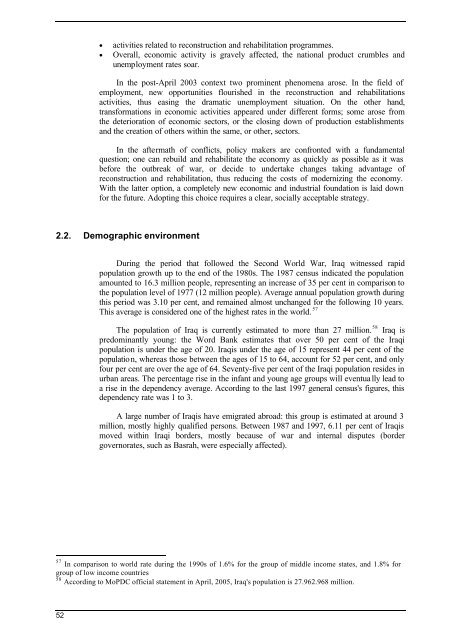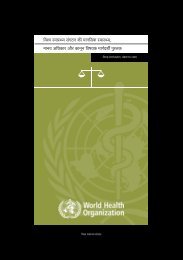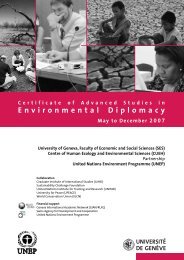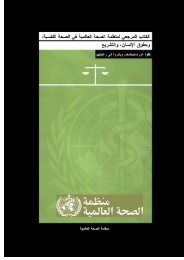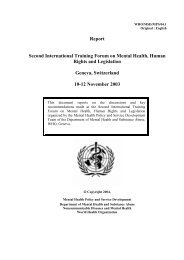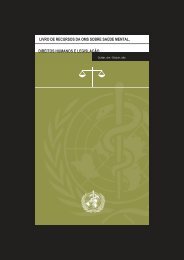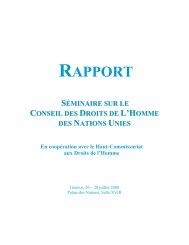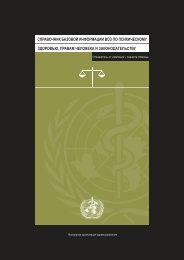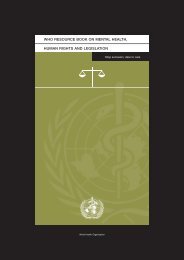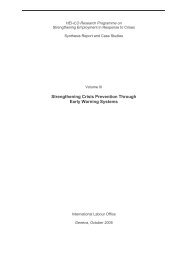• activities related to reconstruction and rehabilitation programmes.• Overall, economic activity is gravely affected, the national product crumbles andunemployment rates soar.In the post-April 2003 context two prominent phenomena arose. In the field ofemployment, new opportunities flourished in the reconstruction and rehabilitationsactivities, thus easing the dramatic unemployment situation. On the other hand,transformations in economic activities appeared under different forms; some arose fromthe deterioration of economic sectors, or the closing down of production establishmentsand the creation of others within the same, or other, sectors.In the aftermath of conflicts, policy makers are confronted with a fundamentalquestion; one can rebuild and rehabilitate the economy as quickly as possible as it wasbefore the outbreak of war, or decide to undertake changes taking advantage ofreconstruction and rehabilitation, thus reducing the costs of modernizing the economy.With the latter option, a completely new economic and industrial foundation is laid downfor the future. Adopting this choice requires a clear, socially acceptable strategy.2.2. Demographic environmentDuring the period that followed the Second World War, Iraq witnessed rapidpopulation growth up to the end of the 1980s. The 1987 census indicated the populationamounted to 16.3 million people, representing an increase of 35 per cent in comparison tothe population level of 1977 (12 million people). Average annual population growth duringthis period was 3.10 per cent, and remained almost unchanged for the following 10 years.This average is considered one of the highest rates in the world. 57The population of Iraq is currently estimated to more than 27 million. 58 Iraq ispredominantly young: the Word Bank estimates that over 50 per cent of the Iraqipopulation is under the age of 20. Iraqis under the age of 15 represent 44 per cent of thepopulation, whereas those between the ages of 15 to 64, account for 52 per cent, and onlyfour per cent are over the age of 64. Seventy-five per cent of the Iraqi population resides inurban areas. The percentage rise in the infant and young age groups will eventua lly lead toa rise in the dependency average. According to the last 1997 general census's figures, thisdependency rate was 1 to 3.A large number of Iraqis have emigrated abroad: this group is estimated at around 3million, mostly highly qualified persons. Between 1987 and 1997, 6.11 per cent of Iraqismoved within Iraqi borders, mostly because of war and internal disputes (bordergovernorates, such as Basrah, were especially affected).57In comparison to world rate during the 1990s of 1.6% for the group of middle income states, and 1.8% forgroup of low income countries58According to MoPDC official statement in April, 2005, Iraq's population is 27.962.968 million.52
2.3. Social environmentInternationally, the level of human development is measured by three key indictors:health, education, and income.2.3.1. IncomesRises in the consumer price index amounted to 6,943 for 2003, with an index 100 in1993, i.e. a rise by cumulative annual rate of 53 per cent.Current statistics claim that about 7 million people of Iraq's total population (27million) are dependent on food-rationing. The regression in Iraqi households’ standard ofliving is also reflected by the large proportional increase of expenditures on foodstuffs.While this percentage does not exceed 20 per cent in the developed countries, Iraqifamilies currently spend more than 60 per cent of their earnings on food, compared with 45per cent in the mid-1980s.2.3.2. EducationThe widepsread deterioration that was inflicted on the educational system wasreflected in student enrolment rates throughout the educational stages. Despite the increasein the number of students, this does not by all means reflect or match the populationgrowth. 59Table 1: Net Enrolment Rates (NER)YearStudent NER6 years (grade 1 primary)% 6-11 years (primary)% 15-17 years (secondary)%1987-1988 84.9 89.5 19.12001-2002 82.6 88.5 13.9Primary school enrolment fell to 93 per cent in 2000, 60 while secondary schoolenrolment dropped from 47 to 38 per cent. Furthermore a large drop in school attendancewas also evidenced. A United Nations Children’s Fund-led (UNICEF) Multiple IndicatorCluster Survey (MICS) reported in 2000 that as many as 23 per cent of primary school agechildren were not attending school (while formally enrolled), with significantly higherrates among girls and in rural areas. This deterioration created or exacerbated inequities bygender, urban/rural areas and region.Other sub-sectors, especially technical and vocational education, also experiencedstagnation or decline. From 1987 to 2002 the number of vocational institutes declined from248 to 235. The decrease in the number of enrolled students has been dramatic, down from144,303 to 65,377. As for children of pre-school age, the number of kindergartenestablishments fell from 594 to 566 between 1987 and 2002, and likewise the number ofregistered children from 76,558 to 68,179. Despite the increase in student enrolment rates59 Primary Education (Grades 1-6); Secondary Education (Grades 7-12), the latter divided into IntermediateEducation (Grades 7-9) and Preparatory Education (Grades 10-12).60 Except where otherwise indicated, educational data cited in this report are drawn from UNESCO (2003)Situation Analysis of Education in Iraq 2003, UNESCO, Paris, April 2003, and UNICEF/World Bank (2003)Social Sector Watching Brief Iraq (Education), New York/Washington, 2003.53
- Page 1 and 2:
HEI-ILO Research Programme onStreng
- Page 3:
PrefaceThis three-volume series res
- Page 7 and 8:
Table of contentsPreface...........
- Page 9: The Private Sector and Social Partn
- Page 13: Executive summaryPrivate enterprise
- Page 16 and 17: IGOs, NGOs—tend to exclude, or at
- Page 18 and 19: • The World Bank has created a kn
- Page 20 and 21: 2. Private enterprises in conflict-
- Page 22 and 23: Figure 1: The Private Sector Employ
- Page 24 and 25: 2.3. Case study: Promoting multi-et
- Page 26 and 27: downstream, i.e. refining and distr
- Page 28 and 29: Box 1: How does Somalia’s private
- Page 30 and 31: Sectoral aspectsthere will be added
- Page 32 and 33: inequities in pricing. “Of the 16
- Page 34 and 35: into the armies are thereby also at
- Page 36 and 37: 3. Private enterprises and social p
- Page 38 and 39: Two natural disasters which have be
- Page 40 and 41: Box 4: Cooperatives in crisis respo
- Page 42 and 43: partners, the tripartite cooperatio
- Page 44: 36forces and that are able to perfo
- Page 48: AcknowledgmentsThe authors of this
- Page 51 and 52: 6.2. Delimiters of women’s econom
- Page 54 and 55: Executive summaryDespite the rich n
- Page 56 and 57: 1. IntroductionSince 1979, under th
- Page 58 and 59: 2. Country profileThe Republic of I
- Page 62 and 63: for university education concerning
- Page 64 and 65: 2.4. Economic environment assessmen
- Page 66 and 67: Unemployment (15 years of age and a
- Page 68 and 69: 2.5. PerspectivesDespite devastatio
- Page 70 and 71: 3. The rationale of SME sector deve
- Page 72 and 73: 4. Iraq's SME sector: A profile4.1.
- Page 74 and 75: The Private sector employment pyram
- Page 76 and 77: Table 8: Estimates of total formal
- Page 78 and 79: Feasibility study: almost all respo
- Page 80 and 81: Table 9: Percentage of female entre
- Page 82 and 83: Factors for public sector preferenc
- Page 84 and 85: The recessionary indication of busi
- Page 86 and 87: Special investment legislation and
- Page 88 and 89: 8. Small entrepreneurs in Iraq: Sto
- Page 90 and 91: a reasonable income and independenc
- Page 92 and 93: 9. RecommendationsSME-development s
- Page 94 and 95: Longer-term SME developmentBesides
- Page 96 and 97: • literature and artistic service
- Page 98 and 99: 2. List of interviews with governme
- Page 100 and 101: 11. Why did you decide establishing
- Page 102 and 103: 33. What are the cost components of
- Page 104 and 105: 59. Are you working on a project, o
- Page 106: Promoting multi-ethnic stakeholder
- Page 109 and 110: 101
- Page 111 and 112:
103
- Page 113 and 114:
105
- Page 115 and 116:
107
- Page 117 and 118:
109
- Page 119 and 120:
Research methodologyThe research te
- Page 121 and 122:
possibility of conflict. In 1992, a
- Page 123 and 124:
2.2.2. PovertyAfter the break-up of
- Page 125 and 126:
of almost 10 per cent of GDP, yet i
- Page 127 and 128:
Source of initial financing: privat
- Page 129 and 130:
‘It is important to point out tha
- Page 131 and 132:
4.2. The economic resilience of int
- Page 133 and 134:
medium-sized companies employing 24
- Page 135 and 136:
5.2. Addressing constraints for SME
- Page 137 and 138:
5.4. Support to local initiativesSM
- Page 139 and 140:
ConclusionConsidering the actual an
- Page 141 and 142:
Scott, Norman: Macedonia: A Brief E
- Page 143 and 144:
Official gross reserves 4 290 450 7
- Page 145 and 146:
4. Survey questionnaire1. Name of t
- Page 147 and 148:
139
- Page 149 and 150:
141
- Page 151 and 152:
143
- Page 153 and 154:
2. Le contexte2.1. Le paradoxe ango
- Page 155 and 156:
Composition et description des Futu
- Page 157 and 158:
Les généraux angolais sont prése
- Page 159 and 160:
Les syndicats officielsL’Union na
- Page 161 and 162:
Une étude réalisée en 2003 pour
- Page 163 and 164:
3.3. Sortir du cercle vicieux : vie
- Page 165 and 166:
Annexes1. Morceaux choisis : le «
- Page 167 and 168:
159
- Page 169 and 170:
L’implication des partenaires soc
- Page 171 and 172:
Table des matièresTable des matiè
- Page 173 and 174:
RemerciementsQu’il me soit permis
- Page 175 and 176:
Liste des acronymesAFASPAALEANEAANS
- Page 177 and 178:
GlossaireAide d’urgence :Aléa :A
- Page 179 and 180:
Résumé exécutifAu cours des dix
- Page 181 and 182:
1. IntroductionLe département de R
- Page 183 and 184:
Limites de l’étudeAvant de proc
- Page 185 and 186:
évalué à plus de deux milliards
- Page 187 and 188:
2.2.2. Aspects démographiquesLes p
- Page 189 and 190:
2.3.3. EducationDès l’indépenda
- Page 191 and 192:
création de fonds de stabilisation
- Page 193 and 194:
3. Analyse des formes de réponse :
- Page 195 and 196:
• le secteur de l’Eau sera dest
- Page 197 and 198:
• la révision de la législation
- Page 199 and 200:
de main-d’œuvre, encourageant la
- Page 201 and 202:
leur fournissait les équipements e
- Page 203 and 204:
matérielle sous des formes diverse
- Page 205 and 206:
centre de l’attention des partena
- Page 207 and 208:
• le rôle dévolu à la commissi
- Page 209 and 210:
Renforcer le rôle de solidarité d
- Page 211 and 212:
ConclusionLa dimension de la tache
- Page 213 and 214:
Equipe Multidisciplinaire pour l’
- Page 215 and 216:
2. Séries statistiquesTable 8 : Ev
- Page 217 and 218:
Table 11 : Répartition de la popul
- Page 219 and 220:
Table 2 : Liste détaillée des com
- Page 221 and 222:
Table 4 : Dispositif d’interventi
- Page 223 and 224:
Organisation de l’unité syndical
- Page 225 and 226:
- Centre technique de construction.
- Page 227:
219


